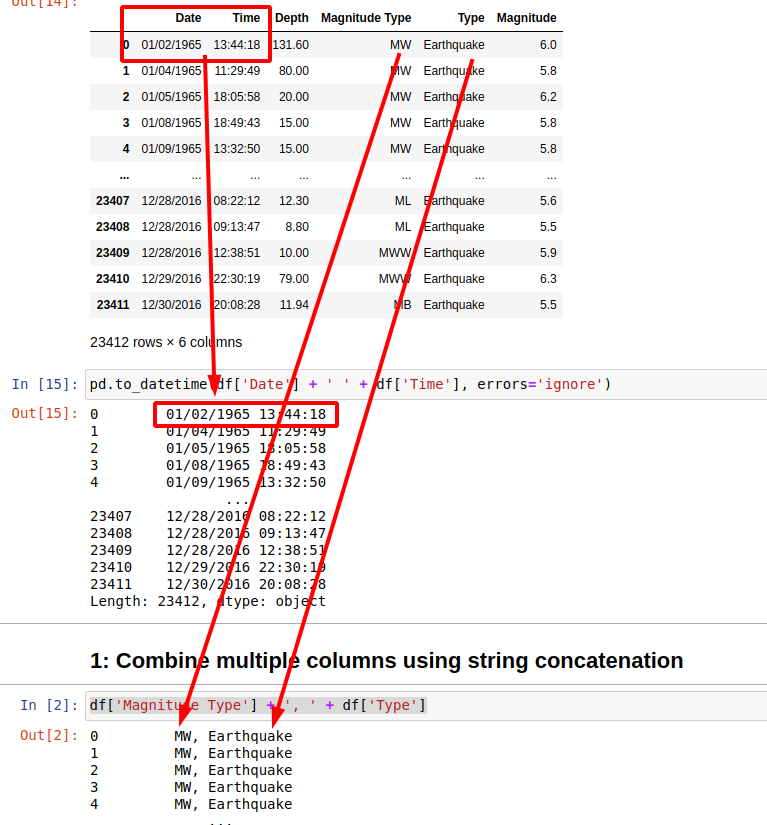pandas将多列合并为单列
[Combine Multiple columns into a single one in Pandas](https://datascientyst.com/combine-multiple-columns-into-single-one-in-pandas/)
Combine Multiple columns into a single one in Pandas
In this short guide, you'll see how to combine multiple columns into a single one in Pandas.
Here you can find the short answer:
(1) String concatenation
(2) Using methods agg and join
(3) Using lambda and join
So let's see several useful examples on how to combine several columns into one with Pandas.
Suppose you have data like:
| Date | Time | Depth | Magnitude Type | Type | Magnitude |
|---|---|---|---|---|---|
| 01/02/1965 | 13:44:18 | 131.6 | MW | Earthquake | 6.0 |
| 01/04/1965 | 11:29:49 | 80.0 | MW | Earthquake | 5.8 |
| 01/05/1965 | 18:05:58 | 20.0 | MW | Earthquake | 6.2 |
| 01/08/1965 | 18:49:43 | 15.0 | MW | Earthquake | 5.8 |
| 01/09/1965 | 13:32:50 | 15.0 | MW | Earthquake | 5.8 |
1: Combine multiple columns using string concatenation
Let's start with most simple example - to combine two string columns into a single one separated by a comma:
result will be:
0 MW, Earthquake
1 MW, Earthquake
2 MW, Earthquake
3 MW, Earthquake
4 MW, Earthquake
What if one of the columns is not a string? Then you will get error like:
TypeError: can only concatenate str (not "float") to str
To avoid this error you can convert the column by using method .astype(str):
result:
0 MW, 6.0
1 MW, 5.8
2 MW, 6.2
3 MW, 5.8
4 MW, 5.8
2: Combine date and time columns into DateTime column
What if you have separate columns for the date and the time. You can concatenate them into a single one by using string concatenation and conversion to datetime:
In case of missing or incorrect data we will need to add parameter: errors='ignore' in order to avoid error:
ParserError: Unknown string format: 1975-02-23T02:58:41.000Z 1975-02-23T02:58:41.000Z

3: Combine multiple columns with agg and join
Another option to concatenate multiple columns is by using two Pandas methods:
aggjoin
result:
0 01/02/1965,13:44:18
1 01/04/1965,11:29:49
2 01/05/1965,18:05:58
3 01/08/1965,18:49:43
This one might be a bit slower than the first one.
4: Combine multiple columns with lambda and join
You can use lambda expressions in order to concatenate multiple columns. The advantages of this method are several:
- you can have condition on your input - like filter
- output can be customised
- better control on dtypes
To combine columns date and time we can do:
In the next section you can find how we can use this option in order to combine columns with the same name.
5: Combine columns which have the same name
Finally let's combine all columns which have exactly the same name in a Pandas DataFrame.
First let's create duplicate columns by:
A general solution which concatenates columns with duplicate names can be:
This will result into:
| Date | Depth | Magnitude | Magnitude Type | Type |
|---|---|---|---|---|
| 01/02/1965,13:44:18 | 131.6 | 6.0 | MW | Earthquake |
| 01/04/1965,11:29:49 | 80.0 | 5.8 | MW | Earthquake |
| 01/05/1965,18:05:58 | 20.0 | 6.2 | MW | Earthquake |
| 01/08/1965,18:49:43 | 15.0 | 5.8 | MW | Earthquake |
| 01/09/1965,13:32:50 | 15.0 | 5.8 | MW | Earthquake |
How does it work? First is grouping the columns which share the same name:
result:
('Date', Date Date
0 01/02/1965 13:44:18
1 01/04/1965 11:29:49
2 01/05/1965 18:05:58
3 01/08/1965 18:49:43
4 01/09/1965 13:32:50
... ... ...
23407 12/28/2016 08:22:12
23408 12/28/2016 09:13:47
23409 12/28/2016 12:38:51
23410 12/29/2016 22:30:19
23411 12/30/2016 20:08:28
[23412 rows x 2 columns])
('Depth', Depth
0 131.60
1 80.00
2 20.00
3 15.00
4 15.00
... ...
23407 12.30
23408 8.80
Then it's combining their values:
result:
Date [[01/02/1965, 13:44:18], [01/04/1965, 11:29:49...
Depth [[131.6], [80.0], [20.0], [15.0], [15.0], [35....
Magnitude [[6.0], [5.8], [6.2], [5.8], [5.8], [6.7], [5....
Magnitude Type [[MW], [MW], [MW], [MW], [MW], [MW], [MW], [MW...
Type [[Earthquake], [Earthquake], [Earthquake], [Ea...
Finally there is prevention of errors in case of bad values like NaN, missing values, None, different formats etc.


